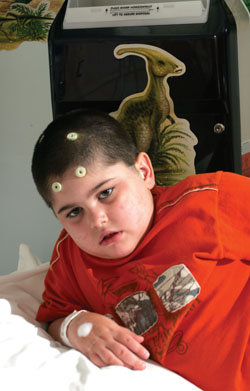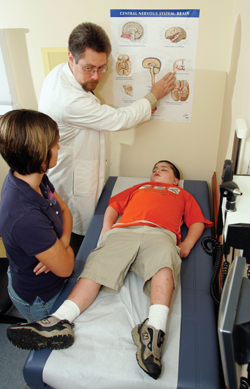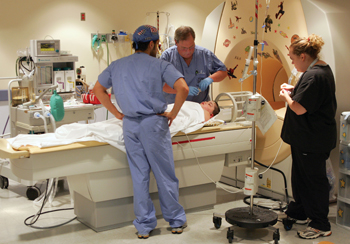
Trevor Lawson came to Vanderbilt to undergo brain surgery to help control his debilitating seizures. (photo by Neil Brake)
Surgery helps calm the storm inside boy’s brain

Matthew Pearson, M.D., discusses the surgery with Trevor Lawson and his mother, Brandy Lawson. (photo by Neil Brake)

Christopher Lemelle, M.D., left, Robert Atwood, C.R.N.A., and CT tech Shilon Burns prepare Trevor for his MRI. (photo by Neil Brake)
When he was only 4 years old, Trevor Lawson began to have “incidents.”
The first one was after a high fever. His right side constricted, his left eye closed, the left side of his face drooped and he was left speechless.
The “incidents” were a storm raging in Trevor's brain, the storm of a seizure – electrical impulses swirling wildly, stunning his brain and stopping him in his tracks.
Each seizure only lasted from seconds to a few minutes, but within a month they became relentless. If it was a bad flare-up he would suffer between 20 and 40 in a day.
“He went from a normally developing, talkative 4-year-old, even writing his name, to sometimes having several seizures an hour,” said his mother, Brandi Lawson. “That's when he started not recognizing loved ones. He would sleep a lot, and stopped playing. It got to where you couldn't understand him, and that lasted for six or nine months.”
Medications were found to quiet the seizures, and they worked, sometimes for months at a stretch, but the seizures always came back. Today, at age 8, the flare-ups last for weeks, and have set Trevor back developmentally, socially and in almost every aspect of his life.
“He's not able to do a lot of the things other kids his age can do, like riding a bike and playing sports,” said Brandi Lawson, “But he tries so hard to play outside with his 5-year-old brother. They play kickball. He loves to play.”
Finding a solution
Trevor's doctor Eric Pina-Garza, M.D., associate professor of Pediatric Neurology at the Monroe Carell Jr. Children's Hospital at Vanderbilt, contacted Pediatric Neurosurgeon Matthew Pearson, M.D., and suggested a radical solution – one that effectively would remove half of Trevor's brain.
“Because all the seizure activity has been isolated on the left side of Trevor's brain, over time, the right side of his brain has taken over all essential functions of life and learning,” said Pearson. “The problem is that because the two sides of the brain are connected and communicate with one another, the seizing side also affects the good side, interrupting the function of both sides of the brain when a seizure is under way.”
Trevor was an ideal candidate for a fairly uncommon surgery called a hemispherectomy. The term literally means the removal of one side of the brain, although recently, changes in technique make it possible to leave a sizeable section of the seizure-affected brain behind to preserve blood flow and avoid scarring.
“The goal of the hemispherectomy is to divide the connective superhighway of communications between the two sides of the brain: a broad, white band of fibers called the corpus callosum,” Pearson said. “Historically, in what we used to call total hemispherectomy, they simply removed the entire affected half of the brain, but that could lead to dangerous bleeding during surgery, and we found scar tissue would actually encroach on the remaining side, affecting the function of the good side of the brain.”
While the first radical hemispherectomies for severe seizure disorder were performed in the 1930s, only in the last 10 years has the less radical version been honed and perfected, especially in children. Now success rates are very good for children as young as 6 months through adulthood. But the younger the patient, the better chance the malleable brain will recover more fully.
The procedure
Trevor's surgery took place on July 26. Pearson shaved only a thin row of hair over the line he would use for a large U-shaped incision above Trevor's left ear. He carefully folded a flap of Trevor's scalp down, exposed the skull and opened the brain cavity. The target, the corpus callosum, lay two-to-three inches inside the brain.
“We use a system called the Stealth stereotactic navigation system that uses an MRI-based, 3-D model of brain and a wireless probe to steer us through the brain tissue without hitting blood vessels, and, more importantly, without damaging structures like the basal ganglia and thalamus, which control movement on both sides of the body,” Pearson said.
A section of the parietal lobe, the brain matter above Trevor's left ear, was removed to expose the tightly wrapped cords of the corpus callosum. Pearson used a combination of cauterizing probe and small scissors to cut the cord, isolating the seizure-ridden left brain from Trevor's normal right brain.
What about right-brain, left-brain learning, with centers for music, math and language housed in one half or the other? Pearson says, especially when seizures begin at a young age, the brain is so malleable it moves those centers to the unaffected side. Pre-surgery testing proved that Trevor's language skills would remain intact, although some of his peripheral vision would most likely be lost.
The road back
As for concerns about Trevor's personality or his memory, his mother, Brandi Lawson, said Trevor is “all there” after surgery, and what's more, just three days after surgery he was home and preparing for the start of the school year.
“We've been going over simple counting books he likes to read, and it's like his short-term memory wasn't there, but now he has it,” Brandi said. “We'll talk about numbers and he's remembering things he wasn't able to before. But the very best part is he hasn't had one seizure.”
It was a remarkable recovery, with less discomfort and scarring than his family expected and a complete cessation of seizures immediately after surgery – or, more accurately, no remaining signs of seizure activity. Pearson explains that because much of the brain tissue in his affected left-brain was left-behind, it's likely seizures continue…“but without the connective cords of communication, the left brain can seize all it wants without affecting the right side.”
The side of Trevor's brain that now controls almost all his central nervous system function has been freed from those periodic “brain storms” that would often wipe out what he just learned, and stun Trevor into a stupor.
Now, Trevor will slowly be weaned off his 12 or so seizure and seizure-side-effect medications, drugs that his mother says “knock him down,” making him sleepy and less able to learn.
Brandi Lawson is hopeful, for the first time, that her son may begin to regain many of the skills he has lost over the last four, seizure-riddled years, things like reading, writing, playing ball. She hopes, in this case, the loss of half of his brain will give her son a whole new future.













